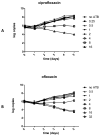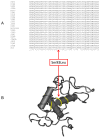Intrinsic fluoroquinolone resistance in Orientia tsutsugamushi
- PMID: 20138477
- PMCID: PMC7610924
- DOI: 10.1016/j.ijantimicag.2009.11.019
Intrinsic fluoroquinolone resistance in Orientia tsutsugamushi
Abstract
Scrub typhus is a public health concern for a population of over a billion humans, with an estimated incidence of one million cases/year in endemic areas. Although doxycycline remains the standard therapy, fluoroquinolones have been used successfully in a few patients. However, there is also clinical evidence that fluoroquinolones are ineffective in the treatment of scrub typhus. To clarify this matter, we determined the in vitro susceptibility of Orientia tsutsugamushi strain Kato to ciprofloxacin and ofloxacin and sequenced the quinolone resistance-determining region (QRDR) of the gyrA gene, the target of fluoroquinolones, of 18 fresh isolates from the Lao PDR. Orientia tsutsugamushi strain Kato was resistant to ciprofloxacin and ofloxacin in vitro (minimum inhibitory concentration=8 microg/mL). All sequences obtained, including those from the two available genomes of O. tsutsugamushi (strains Boryong and Ikeda), had a Ser83Leu mutation in their QRDR domain that is known to be associated with fluoroquinolone resistance. These findings re-emphasise the usefulness of in silico analysis for the prediction of antibiotic resistance and suggest that fluoroquinolones should not be used in the treatment of scrub typhus.
(c) 2009 Elsevier B.V. and the International Society of Chemotherapy. All rights reserved.
Conflict of interest statement
None declared.
Figures


Similar articles
-
Inappropriateness of quinolone in scrub typhus treatment due to gyrA mutation in Orientia tsutsugamushi Boryong strain.J Korean Med Sci. 2013 May;28(5):667-71. doi: 10.3346/jkms.2013.28.5.667. Epub 2013 May 2. J Korean Med Sci. 2013. PMID: 23678256 Free PMC article.
-
In Vitro Activity of Tigecycline Against Orientia tsutsugamushi.Yonsei Med J. 2016 Jul;57(4):1034-7. doi: 10.3349/ymj.2016.57.4.1034. Yonsei Med J. 2016. PMID: 27189302 Free PMC article.
-
Azithromycin activities against Orientia tsutsugamushi strains isolated in cases of scrub typhus in Northern Thailand.Antimicrob Agents Chemother. 1999 Nov;43(11):2817-8. doi: 10.1128/AAC.43.11.2817. Antimicrob Agents Chemother. 1999. PMID: 10543774 Free PMC article. Clinical Trial.
-
Drug treatment of scrub typhus.Trop Doct. 2011 Jan;41(1):1-4. doi: 10.1258/td.2010.100311. Trop Doct. 2011. PMID: 21172901 Review.
-
Orientia tsutsugamushi: An Unusual Intracellular Bacteria-Adaptation Strategies, Available Antibiotics, and Alternatives for Treatment.Curr Microbiol. 2024 Jun 21;81(8):236. doi: 10.1007/s00284-024-03754-1. Curr Microbiol. 2024. PMID: 38907107 Review.
Cited by
-
Childhood encephalitis in the Greater Mekong region (the SouthEast Asia Encephalitis Project): a multicentre prospective study.Lancet Glob Health. 2022 Jul;10(7):e989-e1002. doi: 10.1016/S2214-109X(22)00174-7. Lancet Glob Health. 2022. PMID: 35714649 Free PMC article.
-
Scrub typhus with sepsis and acute respiratory distress syndrome.J Clin Microbiol. 2013 Aug;51(8):2787-90. doi: 10.1128/JCM.00463-13. Epub 2013 Jun 12. J Clin Microbiol. 2013. PMID: 23761149 Free PMC article.
-
Anti-Mycoplasma Activity of Daptomycin and Its Use for Mycoplasma Elimination in Cell Cultures of Rickettsiae.Antibiotics (Basel). 2019 Aug 21;8(3):123. doi: 10.3390/antibiotics8030123. Antibiotics (Basel). 2019. PMID: 31438510 Free PMC article.
-
Concurrent Infection with murine typhus and scrub typhus in southern Laos--the mixed and the unmixed.PLoS Negl Trop Dis. 2013 Aug 29;7(8):e2163. doi: 10.1371/journal.pntd.0002163. eCollection 2013. PLoS Negl Trop Dis. 2013. PMID: 24009783 Free PMC article. Review. No abstract available.
-
Comparative effectiveness of azithromycin for treating scrub typhus: A PRISMA-compliant systematic review and meta-analysis.Medicine (Baltimore). 2017 Sep;96(36):e7992. doi: 10.1097/MD.0000000000007992. Medicine (Baltimore). 2017. PMID: 28885357 Free PMC article.
References
-
- Fournier PE, Siritantikorn S, Rolain JM, Suputtamongkol Y, Hoontrakul S, Charoenwat S, et al. Detection of new genotypes of Orientia tsutsugamushi infecting humans in Thailand. Clin Microbiol Infect. 2008;14:168–73. - PubMed
-
- Cracco C, Delafosse C, Baril L, Lefort Y, Morelot C, Derenne JP, et al. Multiple organ failure complicating probable scrub typhus. Clin Infect Dis. 2000;31:191–2. - PubMed
Publication types
MeSH terms
Substances
Grants and funding
LinkOut - more resources
Full Text Sources
Medical

